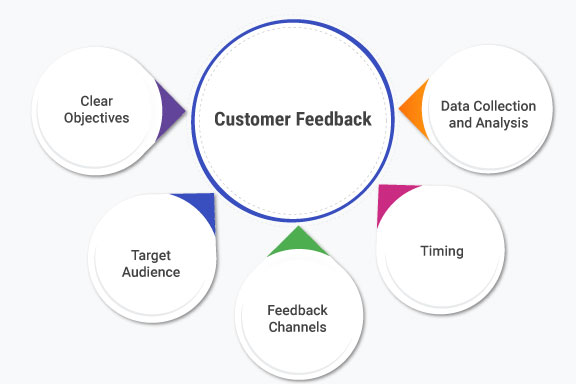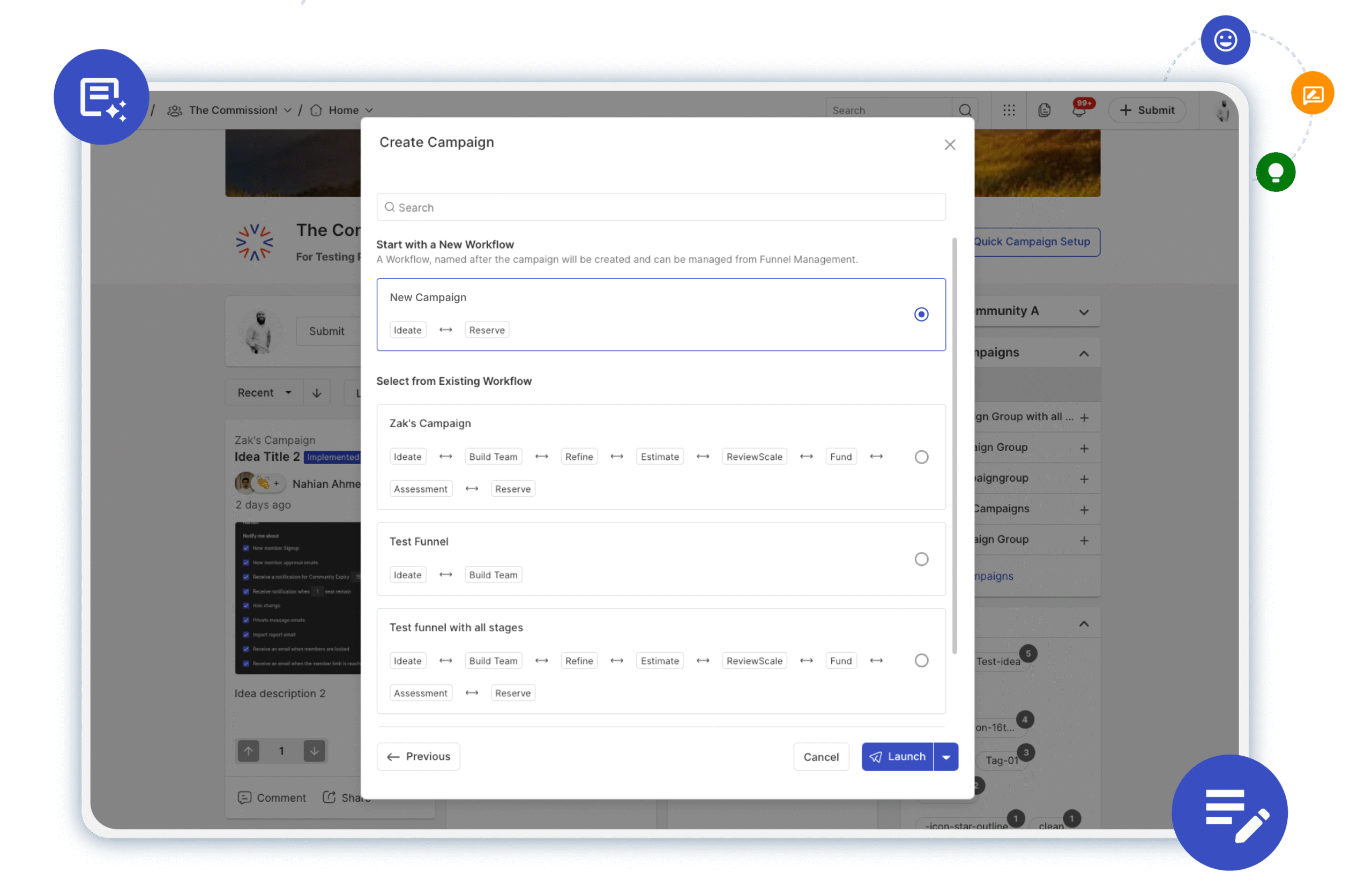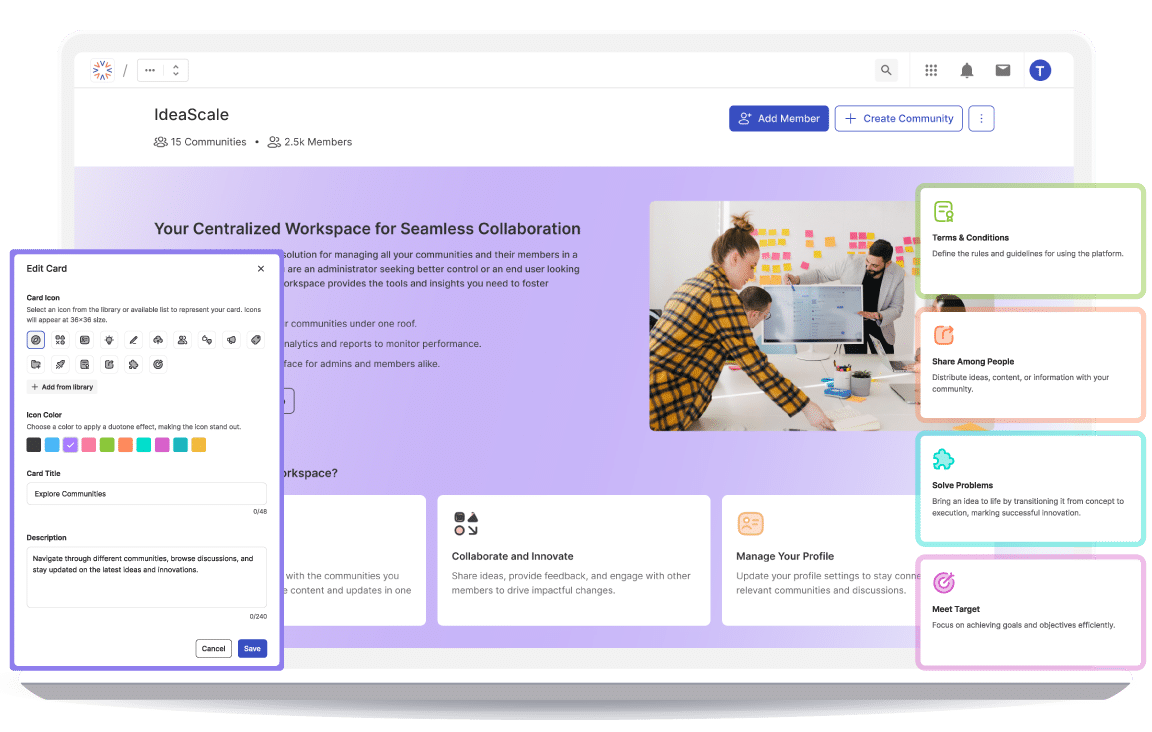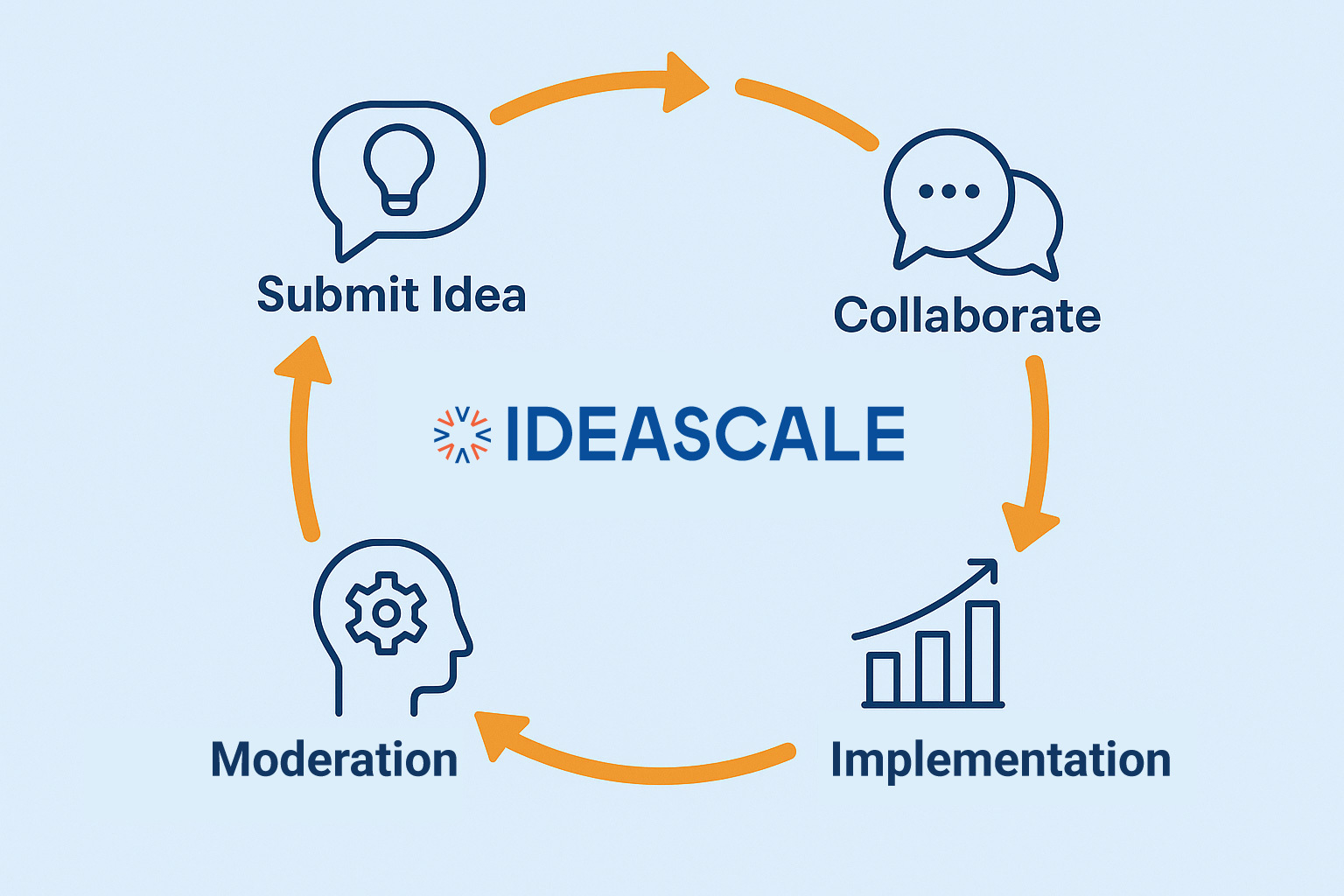Table of Contents
What is Customer Feedback?
Customer feedback refers to the information and opinions that customers provide about their experiences with a company’s products or services. This feedback is essential for businesses to understand what they are doing well and where they can improve. It can come in various forms, including surveys, reviews, social media comments, and direct conversations.
By actively seeking and analyzing customer feedback, businesses can make data-driven decisions to enhance their products, improve customer service, and tailor their offerings to better meet customer needs. Ultimately, leveraging feedback leads to higher customer satisfaction and loyalty.
When collecting customer feedback, there are 5 key components to consider:
- Clear Objectives: Clearly define the objectives of your feedback collection. Determine what specific information you want to gather, such as customer satisfaction, product improvement ideas, or insights on the overall customer experience.
- Target Audience: Identify your target audience for feedback collection. Determine the customer segments or groups that you want to gather feedback from to ensure that the feedback collected is relevant and representative.
- Feedback Channels: Select the appropriate feedback channels based on your target audience and business context. This can include qualitative and quantitative research such as surveys, online reviews, social media, customer support interactions, focus groups, or in-person feedback methods.
- Timing: Determine the timing for feedback collection to capture relevant insights. Consider collecting feedback at different touchpoints in the customer journey, such as after a purchase, interaction with customer support, or product usage.
- Data Collection and Analysis: Implement a systematic process for collecting feedback data. Ensure that data collection is efficient, accurate, and maintains customer privacy. Analyze the feedback data to identify patterns, trends, and actionable insights.
4 Types of Customer Feedback Examples
- Direct Feedback
This type of feedback comes directly from customers via channels like surveys, focus groups, or customer support interactions. Direct feedback is often more explicit and specific, helping companies pinpoint precise areas for improvement.
- Indirect Feedback
Indirect feedback is gathered from customer behavior or interactions, such as website analytics, product usage patterns, or social media mentions. While this feedback is not always given intentionally, it can provide valuable insights into customer preferences and behaviors.
- Public Feedback
Online reviews and ratings on platforms like Google, Yelp, or Trustpilot allow customers to publicly share their opinions. These reviews not only provide feedback to businesses but also influence potential customers who rely on them for decision-making.
- Private Feedback
Private feedback includes personal messages or customer service interactions where customers express their satisfaction or concerns directly to the business. This often provides in-depth and actionable insights that companies can respond to promptly.
Learn more: What is Customer Experience (CX) Research?
Importance of Customer Feedback: Key Factors
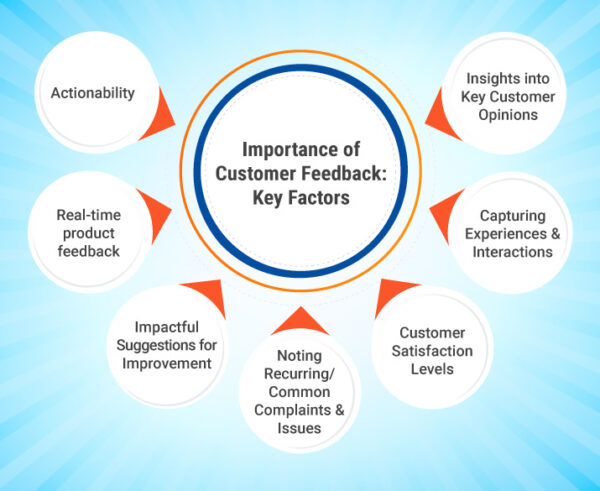
Here are 7 key factors that make periodic customer feedback important for business innovation and growth:
- Insights into Key Customer Opinions
Customer feedback represents the opinions and perceptions of individuals who have interacted with a product or service. It includes their likes, dislikes, preferences, and suggestions for improvement.
- Capturing Experiences and Interactions
Feedback captures the specific customer experience which is with a brand, product, or service. It may include details about interactions with customer service representatives, ease of use, quality, reliability, and overall satisfaction.
- Customer Satisfaction Levels
Customer feedback provides insights into customer satisfaction levels. It helps businesses understand how well they are meeting customer expectations and identify areas where they may be falling short.
- Noting Recurring/ Common Complaints and Issues
Feedback often highlights any problems or issues customers have encountered. This includes identifying specific pain points, defects, or shortcomings in products or services. It provides an opportunity for businesses to address and rectify these issues.
- Impactful Suggestions for Improvement
Customers often provide suggestions or recommendations for improvement based on their experiences. These suggestions can be valuable in shaping product development, enhancing customer service, or refining business processes.
- Real-time product feedback
Customer feedback can be collected in real-time or near real-time, allowing businesses to address issues promptly and make timely improvements to products and services. Gathering feedback in a timely manner, especially for SaaS products, helps capture fresh insights and ensures the feedback changes are added to sprint updates.
- Actionability
Effective customer feedback provides actionable insights that can be used to drive meaningful changes within the organization. It helps businesses identify specific steps to improve products, services, or processes based on the feedback received.
Learn more: What is Focus Group Research?
How to Collect Customer Feedback: 9 Key Channels
There are several channels to collect customer feedback that businesses can utilize. Here are the 8 key customer feedback channels:
1. Surveys: Surveys are a popular and versatile feedback channel. They can be conducted through various mediums such as online forms, email surveys, in-app surveys, or paper-based questionnaires. Surveys allow businesses to collect structured feedback by asking specific questions and rating scales.
2. Online Reviews and Ratings: Customers often share their experiences and provide feedback on online review platforms, social media, or dedicated customer review websites. These platforms allow customers to post written comments, give star ratings, and provide qualitative research feedback about their experiences with products or services.
3. Social Media: Social media platforms like Twitter, Facebook, Instagram, and LinkedIn provide opportunities for customers to engage with businesses and provide feedback. Customers can directly message or mention the company, post comments on company profiles, or participate in discussions related to products or services.
4. Customer Support Interactions: Customer support interactions, such as phone calls, live chats, or email exchanges, can also serve as valuable channels for collecting feedback. Customers often provide feedback during or after support interactions, sharing their experiences, satisfaction levels, or suggestions for improvement.
5. In-Person Interactions: Businesses that have physical locations or engage in face-to-face interactions with customers can collect feedback through in-person channels. This can include comment cards, suggestion boxes, or direct conversations with customers to gather their feedback and suggestions.
6. Focus Groups: Focus groups involve bringing together a small group of customers in a facilitated discussion to gather insights and feedback. This method allows for in-depth exploration of specific topics or products and encourages participants to share their opinions and perspectives.
7. Website Feedback Widgets: Many businesses incorporate feedback widgets or pop-up surveys on their websites to capture visitor feedback. These widgets may prompt customers to rate their website experience, provide suggestions, or report any issues they encounter while browsing or making purchases.
8. Email and Newsletter Surveys: Email surveys can be sent to customers as part of newsletters or standalone feedback requests. This channel allows businesses to collect feedback directly from their customer base and tailor questions specifically to their products, services, or recent interactions.
9. Mobile Apps and In-App Feedback: For businesses with mobile apps, integrating feedback features within the app allows customers to provide feedback conveniently. This can include in-app surveys, feedback forms, or feedback prompts at strategic touchpoints within the app.
5 Examples of Customer Feedback in Action
- Netflix’s User Rating System
Netflix uses customer feedback to personalize recommendations for each user. The company continually refines its algorithm based on what customers rate and review, ensuring a better viewing experience.
- Starbucks’ Idea Crowdsourcing
Starbucks actively seeks customer ideas through its My Starbucks Idea platform, where customers can submit feedback on products, services, or new offerings. Several customer suggestions have been implemented, improving the brand’s connection with its audience.
- Zappos’ Customer Service Improvements
Zappos is known for its outstanding customer service, which they attribute to constantly listening to feedback from customers. The company acts quickly on suggestions, leading to an industry-leading customer experience.
- Amazon’s Product Reviews
Amazon relies heavily on customer reviews to inform both its buyers and its internal teams. Reviews influence product rankings and provide insights that help improve the customer experience across the platform.
- Slack’s User Feedback Loop
Slack has a dedicated feedback channel where users can report bugs, request new features, or share their overall experience. This continuous feedback loop allows Slack to quickly address user needs and enhance its platform.
Best Practices for Customer Feedback Collection and Management
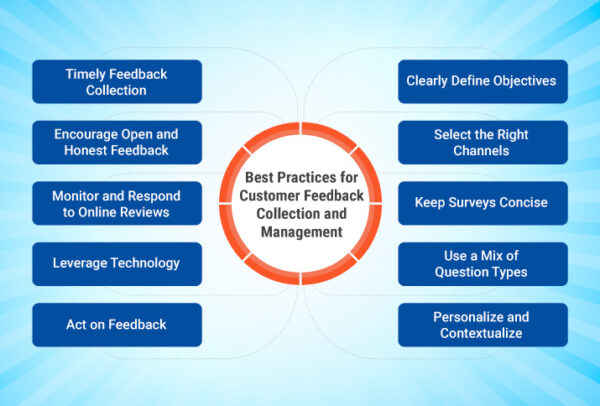
In 2023, businesses can follow these best practices for effective customer feedback collection:
1. Clearly Define Objectives: Clearly define the objectives and goals of your customer feedback collection efforts. Identify what specific insights you are seeking to gather and how you plan to utilize the feedback to drive improvements.
2. Select the Right Channels: Choose the customer feedback channels that align with your target audience and business context. Consider using a combination of channels such as surveys, online reviews, social media, and customer support interactions to capture feedback from diverse sources.
3. Keep Surveys Concise: Design surveys that are concise and focused, avoiding unnecessary or repetitive questions. Respect your customers’ time by making the survey experience as efficient and user-friendly as possible.
4. Use a Mix of Question Types: Incorporate a mix of question types in your surveys, including multiple-choice, rating scales, open-ended questions, and qualitative prompts. This allows for both quantitative and qualitative research insights.
5. Personalize and Contextualize: Personalize your feedback requests by addressing customers by name and tailoring questions to their specific experiences. Provide context for each question to ensure customers understand the relevance and can provide accurate feedback.
6. Timely Feedback Collection: Collect feedback in a timely manner to capture fresh insights while experiences are still fresh in customers’ minds. Consider using real-time feedback collection methods, such as in-app feedback prompts or post-purchase surveys sent shortly after a transaction.
7. Encourage Open and Honest Feedback: Create an environment that encourages customers to provide open and honest feedback. Assure them that their opinions are valued and that their feedback will be used to drive improvements.
8. Monitor and Respond to Online Reviews: Regularly monitor online review platforms and social media channels for customer feedback. Respond promptly and professionally to both positive and negative reviews, demonstrating your commitment to customer satisfaction.
9. Leverage Technology: Utilize technology to streamline feedback collection and analysis processes. Use customer feedback management tools and sentiment analysis software to efficiently collect, analyze, and derive insights from customer feedback at scale.
10. Act on Feedback: Collecting customer feedback is only valuable if it leads to action. Develop processes to analyze feedback, identify trends, and prioritize areas for improvement. Communicate with customers about the changes you’ve made based on their feedback, demonstrating that their opinions are valued.
Customer Feedback Questions
Crafting effective customer feedback questions is crucial for gathering valuable insights that can drive improvements in your products, services, and overall customer experience. Here’s a list of customer feedback questions tailored to various aspects of business:
Product/Service Satisfaction:
- On a scale of 0 to 10, how likely are you to recommend [product/service] to a friend or colleague?
- What do you like most about [product/service]?
- What aspects of [product/service] could be improved?
- How likely are you to recommend [product/service] to a friend or colleague?
- Have you encountered any issues or challenges while using [product/service]? If so, please describe.
- How does [product/service] compare to similar offerings you’ve used in the past?
- Is there any additional feature or functionality you would like to see in [product/service]?
Customer Experience:
- What is your assessment of your overall encounter with our organization?
- Were our customer service representatives helpful and knowledgeable?
- Did you encounter any difficulties while navigating our website or mobile app?
- How satisfied are you with the speed and efficiency of our delivery/service?
- Were your expectations met regarding the quality of our products/services?
- Did you find it easy to contact us for support or assistance when needed?
- What is the probability that you will maintain your business relationship with us in the future?
Brand Perception:
- What thoughts or associations come to mind when you consider our brand?
- To what extent do you believe our brand comprehends and fulfills your requirements?
- What sets our brand apart from competitors in your opinion?
- How would you describe our brand personality?
- Are there any areas where you think our brand could improve?
Market Research/Competitive Analysis:
- How does our product/service stack up against similar offerings from other companies?
- In what areas do you believe our competitors outperform us?
- What factors played a role in your decision to select our product/service instead of other options?
- Are there any features or benefits offered by competitors that you wish we had?
Open-Ended/Qualitative Feedback:
- Can you tell us about a positive experience you’ve had with our company?
- Can you tell us about a negative experience you’ve had with our company and how we could have handled it better?
- What changes or improvements would make you more likely to recommend our products/services to others?
- Is there anything else you would like to share with us about your experience with our company?
These questions can be adjusted and tailored to suit your specific business objectives, target audience, and industry. Additionally, consider using a combination of quantitative (rating scales) and qualitative (open-ended) questions to gather comprehensive feedback.
Learn more: What is Quantitative Market Research?
Most Recent Blogs
Explore the latest innovation insights and trends with our recent blog posts.

